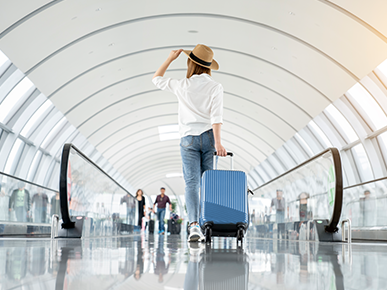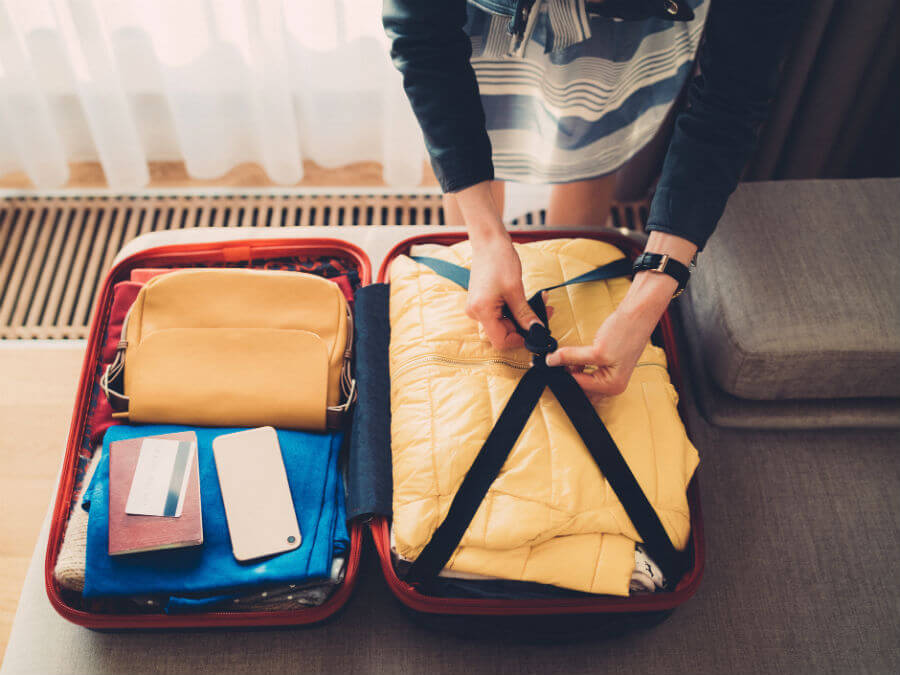
Long-haul flight tips
Aching joints, unreasonable exhaustion, a sudden case of the sniffles: all of these unpleasant symptoms could indicate that you’ve just disembarked a long-haul flight. This is no way to start your holiday, but are we resigned to such a fate? Is it possible to minimise the physical and mental fatigue that seems inevitable after an arduous journey?
Fortunately, yes. While long flights may never be as comfortable as an evening at home, it’s possible to vastly improve your hours in the sky. And since we live in relative isolation from many places, much of our travel time is spent on long flights.
By learning how to protect your health and relax while you travel, you’ll look forward to your holiday and enjoy a comfortable and stress-free flight. In the end, an enjoyable vacation is worth the extra time it takes to prepare for your air travel.
Start your preparations well ahead of your flight
In order to thrive on a long flight, start your preparations early. Otherwise, you may find yourself staying up late the night before your trip because you forgot about a work deadline. Worse, you may forget to pack essential items because you waited until the last minute.
If your calendar shows that a long-haul flight is fast approaching, take action. Some of the following preparations will require a couple of weeks, so set aside some time, and get to work. You’ll thank yourself later.
Logistics
Your pre-flight preparations begin when you first book your flight. If you have any special requests, such as allergy-friendly meals, include this information as you make your reservation. If you’re booking online and don’t see a way to make special requests, contact your airline by phone and make sure they have all the information necessary to make your flight comfortable.
Several weeks before your flight, gather must-have items for your trip. For example, you’ll probably want a neck pillow. While you’re considering your must-have items, plan your cabin luggage carefully. Since you don’t have much room in the overhead compartment or beneath the seats, be sensible in your selections.
Health considerations

Plane cabin humidity is low, usually less than 20%. It’s all too easy to become dehydrated during a long-haul flight, and when you’re dehydrated, you can become vulnerable to cold, flu and other infections.
You can prepare yourself for this dry-air onslaught by providing your body with extra hydration in the days leading up to your trip. Drink more water than usual, and avoid consuming diuretics like caffeinated beverages and alcohol the day before your flight.
Another way to prepare ahead of time is to exercise frequently in the days before your flight. Try to fit a solid workout into your schedule the day before. Exercise releases endorphins, which naturally lower your cortisol levels and help you to better handle the stresses of air travel.
Finally, in the week leading up to your flight, get plenty of sleep. You’ll be better able to deal with the time difference and any unexpected challenges stemming from your travel when you’re well-rested.
Shop for wardrobe items
Don’t wait until the last minute to plan your flight apparel. You’ll want to be comfortable, even if you need to dress professionally while you fly. Since plane cabins tend to be cool, bring a jumper or light jacket that fits easily in your luggage. If you tend to swell during flights, consider wearing a pair of compression stockings.
Layered clothing isn’t just for hiking; it’s also for long-haul flights! A jacket with large pockets can act as an extra carry-on bag, and you can shed as many layers as necessary to adapt to the various temperatures of airports, plane cabins and public transportation when you arrive.
You may also want to consider your footwear. If you wear slip-on shoes for your flight, you’ll have an easier time at security, and you’ll also be able to remove and put on your shoes easily during the flight.
What to pack in your cabin luggage

On a long-haul flight, your cabin luggage is your companion and friend. It’s the source you can go to when you’re cold, tired, bored, hungry, irritated or dirty. The more deliberate you are in your packing, the more likely it is that your cabin luggage can answer every need.
We suggest including the following items in your carry-on:
- Wool socks: cold feet make it difficult to sleep or rest comfortably
- Light jacket: layers are important as the air temperature on planes can be cool at times
- Eye mask: to shield your tired eyes from all of those glaring screens
- Neck pillow: to avoid neck cramps while you’re sleeping
- Earplugs: block out the hum of the cabin so you can rest
- Snacks: aim for healthy snacks that won’t dehydrate you
- Water: a refillable water bottle is best; the cabin crew can refill it for you
- Face wipes: to get rid of that icky travel feeling
- Deodorant: arrive smelling fresh and clean
- Lip balm: the low cabin humidity can quickly take its toll
- Lotion: make it a small tube; airlines usually have a 100ml limits for liquids (you can find this information on your airlines website)
- Pen/paper: you may want to jot down notes or fill in arrival cards
- Entertainment: download movies, music, podcasts, books, etc.
- Toothbrush and toothpaste: freshen up and feel great before you land
Make your health a priority
Enjoy your holiday to the fullest by feeling healthy and energised, beginning to end. Long-haul flights are not always easy on your health. After all, you’re cooped up with a hundred or more people, some of whom may have viruses. Your body must cope with a low-oxygen, low-moisture environment, and you can’t move about freely. But you can minimise your risk of illness by taking the following precautions.
Before the trip

Board your flight in a well-rested state. Exhaustion is not good for your immune system, so be gentle with yourself. If you’re on an overnight flight, get some extra rest the day before. After you arrive at your gate, walk as much as possible before boarding. Not only will this help your muscles to feel better, but it could also reduce your risk of blood clots.
During the flight
- Settle in, and place your most-needed items within easy reach. Make yourself comfortable in your loose-fitting clothing, and fill up your refillable water bottle early in the flight.
- Remember that caffeinated, carbonated and alcoholic drinks are diuretics, so avoid consuming them during the flight. Herbal tea is a good alternative to coffee and caffeinated tea, so bring a few bags with you. Ginger tea can be especially good for nausea and motion sickness, and chamomile may help you fall asleep.
- Avoid eating sugary and starchy foods, as well as foods that give you gas. Sugar can wreak havoc on your blood sugar levels, leaving you irritable and feeling hungry. If possible, snack on fresh fruits and vegetables, nuts, whole-grain crackers and popcorn.
- Move around during the flight as much as you can. When possible, walk up and down the aisle. When this isn’t an option, flex your calf muscles occasionally to keep the blood flowing and avoid clots.
- If you experience ear pain during takeoff and landing, try chewing on gum or sucking on a sweet to help your ears to pop.
- Skin can feel dry and taut in the low humidity of an airplane cabin. Consider bringing a sheet mask for freshening up. Yes, you’ll look a bit crazy for a few minutes, but chances are good that no one will be paying attention to you.
- Finally, keep your hands as clean as possible. A quick coat of hand sanitiser and a tray wipe-down with your cleansing wipes may neutralise those germs that tend to concentrate in plane cabins.

Sleeping on the airplane
We all hope for it. We plan for it. We crave it. Ah, precious sleep.
What can you do to increase your odds of sleeping well during your flight?
- Choose your seat wisely. If possible, request a window seat so you can lean against the wall. Exit rows can be tricky; while you might gain some extra legroom, the chair may not recline, making it more difficult to sleep.
- Avoid consuming caffeine before and during your flight.
- Talk with your doctor about whether a sleeping pill would be helpful to you. For example, melatonin is a hormone that regulates sleep cycles and can be taken in tablet form.
- Use a neck pillow that supports your neck and head, and if possible, choose a neck pillow that attaches to your headrest.
- Wear your wool socks to keep your feet warm while your sleep, and don an eye mask.
- Recline your seat (courteously) and set an alarm to wake you up 30-45 minutes before landing so you have time to wake up gently and gather yourself.
Staying entertained

If you can’t sleep on your flight, all is not lost. Use this precious time away from your email and notifications and daily cares to enjoy your favourite entertainment.
Wi-Fi
With access to Wi-Fi, you can stream movies, listen to your favourite music and much, much more. Check your airline’s Wi-Fi capabilities ahead of time by visiting the airlines website, and bring your own earbuds or headphones for comfort and quality.
Bring your own
If you can’t count on the availability of Wi-Fi, download a movie, TV series, podcast or music onto your phone, tablet or laptop in case you don’t like the in-flight offering. Test your player ahead of time to make sure everything works smoothly, and make sure your devices are fully charged.
Reading material
Alternatively, take a break from the digital world by using your long-haul flight to catch up on your reading. Bring a book or a selection of favourite magazines to indulge in.
Children
If you’re travelling with children, have them pick out their movies and TV series of choice, to keep them occupied at the airport and during the flight. Bring a variety of activities to keep them busy: colouring books and games work well.
Safety precautions
Reduce your chances of having a mishap during your trip by following a few simple safety precautions.
- Wear a small travel bag during your flight that contains important items such as your wallet, passport, cash, emergency contact list, credit cards, and medication
- Don’t leave gadgets or devices on your seat when you go to the bathroom
- Feel under your seat to locate the flotation device, and pay attention to the flight attendants’ security briefing
After the flight

Just because you’ve safely arrived at your destination, doesn’t mean you can forget about your health. In fact, there are a couple of important things you should do after touch down.
First, get some fresh air and sunshine (if possible) in the hours after your arrival. Some people swear by walking barefoot to feel grounded once more. Plan for a good night’s sleep, and try to adjust to your new time zone as quickly as possible. It’s tempting to nap in the middle of the day after a long flight, but resist the temptation, and you’ll recover from jet lag much quicker.
The content of this article is general and provided for information purposes only. Southern Cross Travel Insurance (SCTI) doesn’t guarantee or warrant the accuracy, completeness or currency of any article.
This article may contain hyperlinks to other websites owned or operated by third parties, or references to third party products or services. SCTI isn’t responsible for, and makes no recommendation about, the content or accuracy of any third party website, or for the suitability or performance of any product or service. The inclusion of a link in this article doesn’t imply that SCTI endorses the website or third party product/service.





